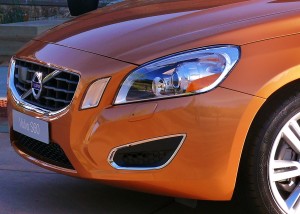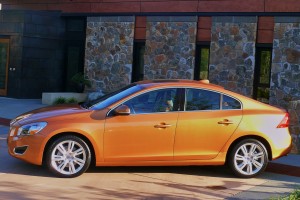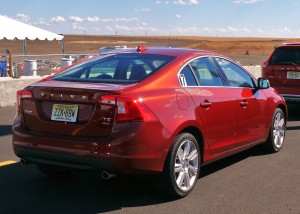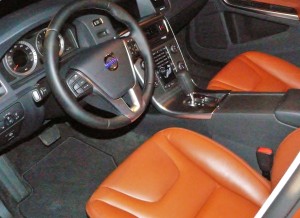Volvo S60 looks hot, drives hot, still safe
NEWBERG, Oregon — Volvo’s long pursuit of safety has been well documented over the years, but less-known is Volvo’s long pursuit of being recognized among the finest European sports sedans. That fact became evident when Volvo introduced the long-awaited S60 to the North American automotive media in mid-September, before the cars reached U.S. showrooms.
Without question, the newest Volvo is the sleekest and sportiest Volvo sedan ever produced, with a strikingly sporty front end and grilled wrapping around its high-tech headlights, and a well-crafted roofline that meets the contemporary standards of being four-door coupe-like. Designed by Orjan Sterner, who was assigned to shape the raciest Volvo in the stable, it will be a big difference after the existing car’s 10-year run. The existing S60 has sold over 600,000, while the new one, built in Ghent, Belgium, is aiming at selling one-third in the U.S., one-third in Europe, and one-third in Asia.
We gathered in suburban Portland, where Volvo officials provided thorough background on the car and its capabilities before we went off on some hard-driving assignments that included hot laps around the road-racing course at Oregon Raceway Park, out near Mount Hood. Before we drove the car, Volvo officials said they anticipated selling it against everything from the Toyota Camry and Honda Accord on up, but its primary targets are the Acura TL, Audi A4, BMW 323 and 335X, the Infiniti G37X, and the Lexus IS-350.
After we had a chance to thoroughly wring out the new S60’s high-powered engine and flat-handling suspension during our day-long driving, the same Volvo officials admitted that its benchmark target was not the Audi A4, but the Audi S4 — the A4’s high-performance specialty car. None of us discounted that lofty ambition, after what we had experienced.
The new S60 has tremendous power, with a, familiar transverse-mounted in-line 6-cylinder engine measuring 3.0 liters of displacement, but internally reinforced and fitted with a twin-scroll turbocharger blowing fuel through 24 valves, activated by dual overhead camshafts. The result is Volvo’s most powerful 6-cylinder engine ever, with 300 horsepower at 5,500 RPMs and a whopping 325 foot-pounds of torque, peaking at 2,100 RPMs and holding that peak until 4,200 RPMs. The driver-adapted 6-speed Geartronic automatic transmission distributes that power to all four wheels.
A new S60 will cost $38,550, on up to $47,050 depending on choices. So intent is Volvo on gaining hot-sedan recognition that it was scarcely mentioned that after the S60 comes to the U.S. in full-out turbo-6 trim, a milder version will become available, equipped with Volvo’s very good inline 5, with or without turbocharging. That version should beat the test car’s 18-city/26-highway fuel economy numbers, even if it won’t match the turbo-6 for performance.
If the look is eye-catching, and the power is definitely Volvo-to-the-highest, the suspension of the car might be its most impressive single feature. Great attention was focused on eliminating the traditional Volvo leaning through sharp cornering. Volvos always have cornered very predictably, and nobody seemed to mind if the slightly stodgy and always-safe Volvos felt as though you might scrape the door handles on the sharpest turns. Nobody, that is, except those trying to compare with an S4, or a Mercedes AMG, or a BMW M3 — the targets Volvo assigned its engineers to catch.
MacPherson struts up front and multilink rear independent suspension both have asymmetricaly mounted coil springs, hydraulic shock absorbers and a stabilizer bar, and the struts have been thickened and the strut mounting stiffness incrased, as are subframe bushings, and the springs are shorter and stiffer. Along with a steering gear’s 10-percent improvement in quickness, the whole package is stiffened by 47 percent. Remarkably, the significantly firmer ride doesn’t ever approach harshness, while delivering vastly improved precision in tracing a curve without a hint of leaning.
The S60 comes with three chassis settings. The Dynamic chassis is standard, and is the same as in European delivery cars, which normally are firmer. The Touring chassis is a no-charge option and is a bit softer. The Four-C — for continuously controlled chassis concept — is an active arrangement with driver-selected choice of Comfort, Sport, or Advanced, and is optional. While the Touring would be the choice for softer coping with rough roads, the greatly stiffened parts of the Dynamic chassis would be the choice for those who like to corner hard. The Four-C, meanwhile, is a technical exercise, with sensors that continously monitor the car’s actions and adjust the dampers in fractions of a second to suit the situation. Engaging Sport mode meant the Geartronic would hold its gear changes longer.
Volvo’s experience with the Haldex all-wheel-drive system fits the latest Haldex perfectly with the steering, suspension and power improvements, and a cornering traction-control system alters the brakes on the inside wheels while adding power to the outside to help you get through a tight turn more effectively.
The race track duty proved the S60’s potential, although I didn’t have my usual enjoyment at Oregon Raceway. The 10-turn track was designed for optimum difficulty, and the designers went overboard to make nearly all the turns blind ones. You speed up a hill, and nothing but memorizing could tip you off to whether it was straight, left, or right on the other side of the crest. I was first in a line of six cars, which meant that all those behind could go hard as possible by keying on the car ahead, but I had nothing to key on, and I only went hard in spurts before letting off on the side of staying on the track. I had far more fun running hard on the curvy highways near Mount Hood on our way to the track.
The S60 is Volvo’s first new car since Ford Motor Company sold the Swedish company to a holding company that also owns Geely Automotive of China. The Chinese financing will help Volvo continue to build its unique cars, and, with a built-in partner, Volvo should rapidly expand its sales success in China. Ford and Volvo helped each other a lot during their relationship, and both seem headed for a prosperous future. For Volvo’s part, that means an unwavering attention to safety. The new S60 underlines that, offering all the proven Volvo concepts, such as lane-departure warning, driver alert control, distance alert, collision warning with full automatic braking, adaptive cruise control with brake assist, and a unique pedestrian detection with full auto brake.
We started our drive in the parking lot, aiming at a small, stuffed, child-size dummy positioned ahead. We were to get up to and hold 20 mph, continuing to steer right at the dummy, without touching the brake. It’s surprising how fast 20 feels as you head for what you’re certain is the inevitable splattering of the little doll, but suddenly — very suddenly, and very close to impact — the brakes are self-activated, hard and right to the point of lockup. And your S60 stops inches short of impact.
A coordinated system that has radar and a camera pointed ahead works seamlessly. The radar in the grille, used also for keeping the adaptive cruise-control space behind a car, detects any object ahead and its distance away; the camera, located on the front facing of the inside rear-view mirror, determines what that object might be. Unbelievable as it sounds, it can detect the swinging of arms or leg motion, comparing it to over 10,000 stored impressions of people, and if it determines that it is a person, the S60 tracks it until you have safely passed. If it steps out in your path as you approach at urban speed, the system will stop the car.
It might drive you crazy in a congested city, or driving through a college campus, where jaywalking seems to be a requisite, because you could find yourself stopping avery 20 feet or so. But Volvo is not joking about such devices. Thomas Broberg, director of Volvo’s amazing safety laboratory in Gothenberg, Sweden, said that in the U.S., 11 percent of all traffic fatalities are pedestrians. Broberg’s focus in recent years has been to keep trying to improve Volvo’s legendary safety, but to strive to find ways to make the driver safer, willing or not.
Volvo started 40 years ago to monitor and compile information from every fatal accident involving a Volvo in Sweden. “We have been able to reduce the risk of fatal crashes in Volvos by 60 percent,” Broberg said, explaining that Volvo also can detect when a driver might be getting sleepy or inattentive, and sound an alert by using the lane-departure technology that sounds if you drift over the dotted line without signaling. “As a driver gets tired, he might drift across the line more, but he also makes more micro-corrections on the steering wheel.”
Keeping the driver alert is a breakthrough in automotive engineering, as is the pedestrian-proof stopping system, which can also help stop the car at any speed when it’s detected to be closing too fast on any object at any speed. At the other end of the spectrum, as we approached the race track in western Oregon, I was second in a group of four S60s when I spotted a small sign that indicated we were supposed to make a 90-degree left turn. The lead car didn’t see it and went straight, as did the third and fourth cars. My reaction, at 60 mph, was sudden as I cranked the steering wheel, and we shot around that corner with incredible precision, and without any leaning.
Amazing that the new S60, which is aimed to take on the hottest-performing midsize cars, is also not about to compromise its intent on building the safest car in its class.
Comments
Tell me what you're thinking...
and oh, if you want a pic to show with your comment, go get a gravatar!







 John Gilbert is a lifetime Minnesotan and career journalist, specializing in cars and sports during and since spending 30 years at the Minneapolis Tribune, now the Star Tribune. More recently, he has continued translating the high-tech world of autos and sharing his passionate insights as a freelance writer/photographer/broadcaster. A member of the prestigious North American Car and Truck of the Year jury since 1993. John can be heard Monday-Friday from 9-11am on 610 KDAL(www.kdal610.com) on the "John Gilbert Show," and writes a column in the Duluth Reader.
John Gilbert is a lifetime Minnesotan and career journalist, specializing in cars and sports during and since spending 30 years at the Minneapolis Tribune, now the Star Tribune. More recently, he has continued translating the high-tech world of autos and sharing his passionate insights as a freelance writer/photographer/broadcaster. A member of the prestigious North American Car and Truck of the Year jury since 1993. John can be heard Monday-Friday from 9-11am on 610 KDAL(www.kdal610.com) on the "John Gilbert Show," and writes a column in the Duluth Reader.